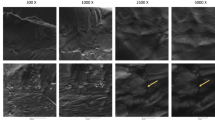Abstract
Degradation of rubber particles from tyre treads, having diameters from 0.8 to 2.3 mm, was achieved using Nocardia sp. 835A-Rc, a mutant strain with strong rubber-degrading ability. The entire surface of the particles was uniformly attacked by the organism either without stirring of the culture medium or at a very low stirring rate of 40 rpm. At a higher rate of stirring, however, a small number of large microbial colonies were formed on the rubber surface and separate deep semi-spherical cavities were observed after the removal of microbial cells by washing. The number of microbial colonies decreased with increasing stirring rate but each one of the colonies became larger at the same time. As the result of these two counteracting effects of stirring on microbial activity, the weight loss of the particles increased when the stirring rate was raised from 0 to 40 rpm but decreased when the rate was increased from 40 to 70 or 150 rpm. At the stirring rate of 40 rpm, the weight losses of the particles with mean diameters of about 0.8, 1.1 and 2.3 mm were 57, 50 and 36%, respectively, after 8 weeks. The rate of microbial degradation increased again when the stirring was raised from 150 to 300 rpm.
Similar content being viewed by others
References
Bode HB, Zeek A, Pleuckhahn K, Jendrossek D (2000) Physiological and chemical investigation on synthetic poly(cis-1,4-isoprene). Appl. Environ. Microbiol. 66: 3680-3685.
Christiansson M, Stenberg B, Wallenberg LR, Holst O (1998) Reduction of surface sulfur upon microbial devulcanization of rubber materials. Biotechnol. Lett. 20: 637-642.
Hesisey RM, Papadatos S (1995) Isolation of microorganisms able to metabolize purified natural rubber. Appl. Environ. Microbiol. 61: 3092-3097.
Kumar SR, Gandhi KS, Natarajan KA (1991) Role of cell attachment in leaching of chalcopyrite minerals by Thiobacillus ferrooxidans Appl. Microbiol. Biotechnol. 36: 278-282.
Linos A, Berekaa MM, Reichelt R, Keller U, Schmitt J, Flemming HC, Kroppenstedt RM, Steinbuechel A (2000) Biodegradation of cis-1,4-polyisoprene rubbers by distinct actinomycetes. Appl. Environ. Microbiol. 66: 1639-1645.
Liu HS, Mead JL, Stacer RG (2000) Environmental effects of recycled rubber in land-fill applications. Rubber Chem. Technol. 73: 551-564.
Romine RA, Romine MF (1998) Rubber-cycle: a bioprocess for surface modification of waste tyre rubber. Polym. Degrad. Stab. 59: 353-358.
Tsuchii A (1995) Microbial degradation of natural rubber. Prog. Ind. Microbiol. 32: 177-187.
Tsuchii A, Tokiwa Y (1999) Colonization and disintegration of tire rubber by a colonial mutant of Nocardia. J. Biosci. Bioeng. 87: 542-544.
Tsuchii A, Takeda K, Suzuki T, Tokiwa Y (1996) Colonization and degradation of rubber pieces by Nocardia sp. Biodegradation 7: 41-48.
Tsuchii A, Takeda K, Tokiwa Y (1997) Degradation of the rubber in truck tires by a strain of Nocardia sp. Biodegradation 7: 405-413.
Warner WC (1994) Methods of devulcanization. Rubber Chem. Technol. 67: 559-566.
Author information
Authors and Affiliations
Corresponding author
Rights and permissions
About this article
Cite this article
Tsuchii, A., Tokiwa, Y. Microbial degradation of tyre rubber particles. Biotechnology Letters 23, 963–969 (2001). https://doi.org/10.1023/A:1010593807416
Issue Date:
DOI: https://doi.org/10.1023/A:1010593807416




